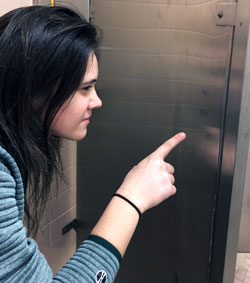McKenna Bent crouched down to look at a splattered footprint on the ground of the girls’ locker room. She wrote a note in her file.
“You can tell from the footprint that it was a man’s shoe. Interesting,” she said.
She continued looking for clues in the locker-turned-crime scene. In the showers, she found fingerprints and other clues that all pointed to a grisly demise, all for the sake of science, of course.

McKenna and her classmates in Sara Weber’s forensic science class were taking a chilling final exam. Instead of a traditional paper test, groups created “crime scenes” for peers to investigate.
Using clues like murder weapons, fingerprints, footprints and belongings left behind, the student sleuths worked as a team to make an assessment as though they were private investigators.
Crime scenes are used in the place of final exams since the skills learned in class are hard to translate to paper, Weber said.
“This way kids can actually practice the skills that we learned in class through simulation,” Weber said. “It makes a lot more sense than just having a multiple choice test that doesn’t really test as much.”

Following the Clues
To complete the requirements of the elective science class, each room had to have five pieces of evidence and a plot that examiners could determine from the clues.
“It gives us the opportunity to be creative and allows us to live in a world where we, for a second, are a private investigator,” McKenna said. “It’s a lot of fun to work with your peers in a creative outlet like this. It’s very different from what you usually do in a classroom.”
Following examinations of each crime scene, students had to file police reports and other paperwork needed in real life investigating.
“You realize how hard it is to actually do this,” said student Will Alt. “There’s a lot of paperwork and police reports and things like that that you don’t even think about having to do. It’s not all lights and action.”
Weber’s idea for the forensic science class came from a fellow teacher at Northview schools years ago. In the future, she would love to include more elements of the forensic science profession.
“This class is really student-based,” she said. “I listen to the students and try to teach them about the things they are interested in in a fun and creative way. We have a lot of fun.”
CONNECT











